Battlestar Galactica: The Captain’s Hand
 Sci-Fi channel airs the 30th episode of Ronald D. Moore’s re-imagining of Battlestar Galactica. Richard Hatch and John Heard guest star.
Sci-Fi channel airs the 30th episode of Ronald D. Moore’s re-imagining of Battlestar Galactica. Richard Hatch and John Heard guest star.
More about Battlestar Galactica in the LogBook and theLogBook.com Store
Battlestar Galactica now streaming on Amazon Prime

 Sci-Fi channel airs the
Sci-Fi channel airs the  ABC airs the
ABC airs the  British toymaker Character Options releases
British toymaker Character Options releases 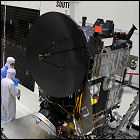 Having been “on hold” since October 2005 pending an audit of technical and managerial issues related to the mission, NASA formally cancels the Dawn unmanned mission to the asteroid belt. The spacecraft had been intended to lift off in 2006, using an ion propulsion system to visit, orbit, and map not one, but two, of the largest bodies in the asteroid belt between Mars and Jupiter, in the following decade. The mission is cancelled when NASA auditors find unresolved technical issues and project a budget overrun of 20%. Planners and managers for the Dawn mission plan to appeal NASA’s decision.
Having been “on hold” since October 2005 pending an audit of technical and managerial issues related to the mission, NASA formally cancels the Dawn unmanned mission to the asteroid belt. The spacecraft had been intended to lift off in 2006, using an ion propulsion system to visit, orbit, and map not one, but two, of the largest bodies in the asteroid belt between Mars and Jupiter, in the following decade. The mission is cancelled when NASA auditors find unresolved technical issues and project a budget overrun of 20%. Planners and managers for the Dawn mission plan to appeal NASA’s decision. Sci-Fi channel airs the
Sci-Fi channel airs the  Sci-Fi channel airs the
Sci-Fi channel airs the  Varese Sarabande releases a CD containing
Varese Sarabande releases a CD containing  The internet-based fan film Star Trek: Phase II releases a short vignette episode,
The internet-based fan film Star Trek: Phase II releases a short vignette episode,  Michael Giacchino’s
Michael Giacchino’s  ABC airs the
ABC airs the 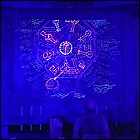 ABC airs the
ABC airs the 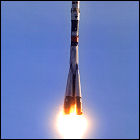 The thirteenth full-time crew of the International Space Station lifts off from Russia’s Baikonur Cosmodrome aboard Soyuz TMA-8. Pavel Vinogradov and Jeffrey Williams take up residence on the ISS for 182 days; during their stay, the ISS crew expands to three with the arrival of Thomas Reiter aboard space shuttle Discovery, marking the remaining shuttle fleet’s temporary return to service. Arriving with them on the ISS for a nine-day stay is Brazilian astronaut Marcos Pontes, who returns to Earth aboard Soyuz TMA-7 with the Expedition 12 crew.
The thirteenth full-time crew of the International Space Station lifts off from Russia’s Baikonur Cosmodrome aboard Soyuz TMA-8. Pavel Vinogradov and Jeffrey Williams take up residence on the ISS for 182 days; during their stay, the ISS crew expands to three with the arrival of Thomas Reiter aboard space shuttle Discovery, marking the remaining shuttle fleet’s temporary return to service. Arriving with them on the ISS for a nine-day stay is Brazilian astronaut Marcos Pontes, who returns to Earth aboard Soyuz TMA-7 with the Expedition 12 crew.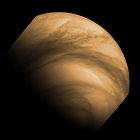 The European Space Agency’s Venus Express space probe – the first unmanned spacecraft to closely examine the second planet from the sun since the late 1970s – arrives at the planet to undertake a detailed study of the atmosphere, the unusually symmetrical cloud patterns of the planet’s north and south hemispheres, as well as observing the massive, hurricane-like vortices which remain over the poles. Venus Express also looks for the source of traces of sulphur dioxide in the Venusian atmosphere, which could be a sign that of active volcanoes on the surface.
The European Space Agency’s Venus Express space probe – the first unmanned spacecraft to closely examine the second planet from the sun since the late 1970s – arrives at the planet to undertake a detailed study of the atmosphere, the unusually symmetrical cloud patterns of the planet’s north and south hemispheres, as well as observing the massive, hurricane-like vortices which remain over the poles. Venus Express also looks for the source of traces of sulphur dioxide in the Venusian atmosphere, which could be a sign that of active volcanoes on the surface.
 Entertainment industry newspaper Daily Variety reports that J.J. Abrams, creator of Lost and Alias, and director/producer of Paramount’s heavily-promoted Mission: Impossible III, has signed a deal to produce and direct the eleventh Star Trek film, which has suddenly moved from “off the schedule” (following the cooling of the studio’s attitude toward the Trek franchise in the wake of the Star Trek: Enterprise cancellation) to a 2008 release date. Fellow Lost producers Bryan Burk and Damon Lindelof are also signed on as producers of the still-untitled movie, which is said to focus on the first mission for a young James T. Kirk and Spock. Mission: Impossible III (and former Xena/Hercules) writers Roberto Orci and Alex Kurtzman are on board as scriptwriters.
Entertainment industry newspaper Daily Variety reports that J.J. Abrams, creator of Lost and Alias, and director/producer of Paramount’s heavily-promoted Mission: Impossible III, has signed a deal to produce and direct the eleventh Star Trek film, which has suddenly moved from “off the schedule” (following the cooling of the studio’s attitude toward the Trek franchise in the wake of the Star Trek: Enterprise cancellation) to a 2008 release date. Fellow Lost producers Bryan Burk and Damon Lindelof are also signed on as producers of the still-untitled movie, which is said to focus on the first mission for a young James T. Kirk and Spock. Mission: Impossible III (and former Xena/Hercules) writers Roberto Orci and Alex Kurtzman are on board as scriptwriters.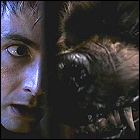

 ABC airs the
ABC airs the 
 ABC airs the
ABC airs the  Soundtrack specialty label Intrada releases a 2-CD limited edition set of soundtrack music from the 1980s anthology series
Soundtrack specialty label Intrada releases a 2-CD limited edition set of soundtrack music from the 1980s anthology series 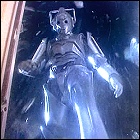
 ABC airs the
ABC airs the 
 NOAA’s GOES-13 Geostationary Operational Environmental Satellite is launched from Cape Canaveral into geosynchronous orbit to monitor weather patterns over the United States. It will be held in reserve until 2010, when it will be moved to the GOES-EAST position to replace GOES-12, which is suffering chronic attitude control thruster glitches. GOES-13 is yet another evolutionary step up in the GOES satellite hardware, but it will suffer its own share of hardware issues, including a series of inexplicable faults which will cause brief losses of weather coverage, and a later fault which disables infrared imaging capability. Some of these hardware failures will be attributed to micrometeoroid collisions.
NOAA’s GOES-13 Geostationary Operational Environmental Satellite is launched from Cape Canaveral into geosynchronous orbit to monitor weather patterns over the United States. It will be held in reserve until 2010, when it will be moved to the GOES-EAST position to replace GOES-12, which is suffering chronic attitude control thruster glitches. GOES-13 is yet another evolutionary step up in the GOES satellite hardware, but it will suffer its own share of hardware issues, including a series of inexplicable faults which will cause brief losses of weather coverage, and a later fault which disables infrared imaging capability. Some of these hardware failures will be attributed to micrometeoroid collisions. ABC airs the
ABC airs the 